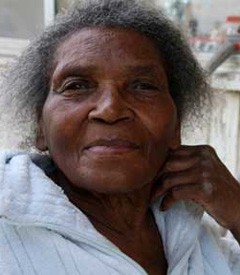Lanare, California – When Mary Broad moved to Lanare in 1955, there were only four other families still living in this tiny, unincorporated community in the middle of the San Joaquin Valley, halfway between old Highway 99 and Interstate 5 on the cracked blacktop of Mt. McKinley Avenue.
It wasn't always this way.
Lanare used to be a company town, taking its name from rancher and speculator L.A. Nares, one of the last of a string of speculators from the east coast who purchased the old Spanish land grants – in his case, the Rancho Laguna de Tache. From 1912 to 1925 the town had a post office and a station on the Laton and Western Railway.
Lanare and neighboring settlements drew their water and life from the Kings River. During the early 1900s, farmers tapped the Kings River in the Sierras to the east, to irrigate their vineyards, orchards and cotton fields in the San Joaquin Valley. As a result, in most years the stretch of river below the mountains became a dry riverbed. Tulare Lake, the river's terminus, was also drained for farmland and eventually disappeared.

So, almost, did the town of Lanare itself. People left the settlement, leaving only a few families behind. But over the last several decades, as California's population grew and the need for housing became acute, Lanare began to grow again. For farm laborers, truck drivers and poor rural working families, living in Lanare was cheaper than urban Fresno fifty miles away.
But for these new residents, a century of using water from the Kings River for farm irrigation has spelled bad news. Today, Lanare's water comes from a well, and in this low-lying area of the San Joaquin Valley, chemicals from agricultural runoff have become concentrated in the water table. It was no surprise, therefore, that residents discovered their water had high concentrations of arsenic, a poison. Since then, their effort to find drinkable water has become a struggle for the life of the town itself.

By 2010, Lanare had grown to 589 residents, with the majority living in trailers. Because most work as laborers in the surrounding fields, a third live under the poverty line. Half the men earn less than $22,000 per year, and half the women less than $16,000.
Today Lanare is one of the many unincorporated communities in rural California that lack the most basic services, like drinking water, sewers, sidewalks and streetlights. According to Policy Link, a foundation promoting economic and social equity, “Throughout the United States, millions of people live outside of central cities on pockets of unincorporated land. Predominantly African-American and Latino, and frequently low-income, these communities … have been excluded from city borders.”

The San Joaquin Valley alone is home to more than 220 unincorporated communities, with an estimated population of almost half a million.
In 2002 Lanare residents won a $1.3 million grant from the Federal government to build a water processing plant to remove the arsenic. But it took five years for the project to be completed, and even then it only ran for six months, because the community's residents no longer had enough money to pay for the chemicals and power to keep it going. Even though the plan has been shut down, however, Lanare residents still have to individually come up with $54 every month to cover the cost of the initial loan – essentially paying for water they can't drink.
Inside every home in Lanare there is a faucet with running water, but residents don't dare use it for anything other than washing clothes and maybe dishes, if they have to. When Angel Hernandez or Isabel Solorio, two local organizers, held a glass up to the light, the water was cloudy. So, in the corner of their homes sit stacks of water bottles for drinking and cooking.

Dozens of small communities like Lanare spread out across the state have similar water problems, prompting activists in 17 unincorporated areas of next-door Tulare County formed AGUA, La Asociacion de la Gente Unida por el Agua (The Association of People United for Water).

Residents have also begun organizing around water rights in Lanare, where Hernandez, Solorio and several other residents including Juventino Gonzalez and Jesus Medina, organized a group called Comunidad Unida en Lanare (Community United in Lanare). As a first step, they asked the state to survey Lanare and the surrounding communities, acknowledge that a need for safe water exists, and develop a plan to meet that need. California Rural Legal Assistance filed a lawsuit in early 2010 on their behalf, arguing that the Safe Drinking Water Act of 1986 requires California to formulate a Safe Drinking Water Plan.
The state hasn't had a Safe Drinking Water Plan in place since 1993. CRLA attorneys point out that if authorities had followed the law and come up with a plan, it would have become obvious years ago that residents of a poor community like Lanare cannot afford to sustain an expensive water treatment plant. Letting the state off the hook, however, a Fresno County judge ruled in February 2010 that California's budget crisis trumped its obligation to create such a plan.

The state budget crisis, however, hasn't stopped nearby Riverdale, only four miles from Lanare, from proposing another arsenic removal plant. The Riverdale Public Utilities District hopes to use funds from Proposition 84, a $5.4 billion water bond. The city was just awarded $500,000 to conduct a preliminary study for a water project that would break ground next year.
Seeing the project in Riverdale as an opportunity to also meet the water needs of residents in nearby Lanare, CRLA lawyer Phoebe Seaton wrote to the state health department, saying that, “Given finite and scarce state and federal resources, the need for a safe, reliable and affordable source of water for both Lanare and Riverdale, and the Department's statutory duty to explore consolidation of water systems, the Department must consider the consolidation of Lanare's and Riverdale's water systems.”

A recent report by Fresno's Local Agency Formation Commission, which is charged with avoiding expensive duplication of municipal and county services, including water, also concluded that “A shared arsenic treatment facility that serves both Riverdale and Lanare would provide operational efficiencies and economies of scale that would improve service, water quality and affordable access to clean water for both communities.” The report even advocates for a system that would allow Lanare residents to abandon failing septic tanks and connect to the sewers of Riverdale.

Public health officials, however, have argued that connecting Lanare to that Riverdale plant, or even expanding Lanare's own idle plant, would be too expensive.
Meanwhile, the state has hired a private contractor to operate the Lanare plant, but the operation is in receivership and hasn't produced water anyone can drink for nine years. The tap water in Lanare is still cloudy, the residents fear drinking it, and they still pay $54 a month for it.
“The government has forgotten us – they live outside our reality,” says Juventino Gonzalez, who moved to Lanare 41 years ago, when it only had 12 families. “All that time we've been isolated from the larger communities around us, while our neighborhood gets filled with drugs and trash. Water's just one problem, but if we can find an answer to it, maybe we can solve others too. We're willing to try almost anything.”

All images are copyright of David Bacon.
Join us in defending the truth before it’s too late
The future of independent journalism is uncertain, and the consequences of losing it are too grave to ignore. To ensure Truthout remains safe, strong, and free, we need to raise $43,000 in the next 6 days. Every dollar raised goes directly toward the costs of producing news you can trust.
Please give what you can — because by supporting us with a tax-deductible donation, you’re not just preserving a source of news, you’re helping to safeguard what’s left of our democracy.
